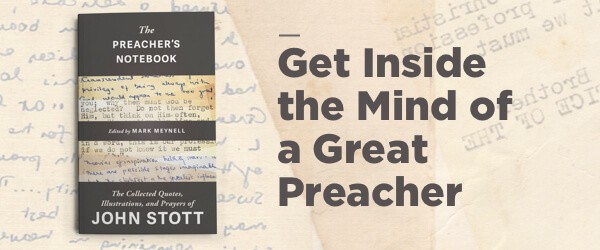John Stott didn’t become one of the most influential evangelical leaders in the twentieth century by happenstance. Like so many preachers before him, he was always looking for ways to strengthen his preaching and ministry. Beginning in the 1940s, when Stott came across something he thought he could use, he captured it on a note card, labeled it according to topic, and filed it away in his study.
In The Preacher’s Notebook, Lexham Press collects 60 years of the quotes, illustrations, anecdotes, and prayers Stott collected—so you can incorporate them into your own life and ministry.
In this excerpt from the book’s introduction, Mark Meynell reflects on his personal experience with “Uncle John” and how this new book captures Stott’s legacy of “blazing clarity.”
Phillips Brooks (of “O Little Town of Bethlehem” fame) once suggested that preaching was “truth through personality.” While this may be insufficient as a definition, it does make the point that you can tell a great deal about preachers’ personalities through the way they communicate truth. This was certainly true of John Stott. As Greg Scharf has said, one of Uncle John’s most remarkable characteristics was his integrity—the consistency between his preaching, writing, and living: “His clear and thoughtful preaching flowed from a disciplined and devoted life and was captured in equally lucid writings.”
Many have noted the wide influence of his teaching, but so often it was precisely the crystalline clarity of what he taught that was the fountainhead of this influence. Every word, every sentence, and every paragraph would be carefully weighed or refined so that he rarely (if ever) uttered an idle thought or contradictory point when in the pulpit. The American pastor John Piper reflected on this in a memorial tribute to him. He noted that Stott had received a complaint about his 1966 commentary in the Bible Speaks Today series, Men Made New (on Romans 5–8), for writing a “book like a house with no windows.” In other words, it had no illustrations. But Piper counters the complaint. Stott, he insists, “turned the words of Bible sentences into windows onto glorious reality by explaining them in clear, compelling, complete, fresh, silly-free English sentences.” Such was his clarity, therefore, that he did not usually require illustrations.
Some teased that his was almost clarity to a fault, in that he could be “clearer on the apostle Paul than Paul himself” (as Judge David Turner reminded us in his funeral tribute). But Stott’s was a clarity that was hard won. As any teacher knows, clear communication requires deep levels of comprehension. This takes time and thought. It demands careful attention to alternative interpretations, controversies, and complexities. Stott was exemplary in his engagement with these—as even his theological critics would concede—and this is where this anthology comes in. It provides genuine insight into the workings of his mind and the discipline of his scholarship.
A John Stott “Commonplace Book”
It probably seems strange to publish an anthology of notes, quotes, and illustrations from the files of a preacher who professed he didn’t “believe in illustrations.” But of course, while he was never one of the great storytellers or showmen, he did become a preacher who took the need to interact with prevailing trends and cultural presumptions with utmost seriousness. To that end, quotations and examples became essential, even if he used them sparingly and carefully.
Any anthology of John Stott’s notes would not be a mere collection of anecdotes and poignant stories (as has been compiled, say, from George Whitefield, Charles Spurgeon, or Donald Grey Barnhouse). That would never quite reflect the Stott style. Apart from anything else, it would probably end up as quite a slim tome. Instead, what you have before you is something more akin to a “commonplace book.”
Many thinkers, poets, artists, travelers, and opinion formers in previous generations used commonplace books. These books were handy places for jotting down thoughts, quotations, ideas, or even sketches or questions. A single page might contain profundity, trivia, and a shopping list. Such books had no order other than the chronology suggested by successive entries.
Of course, those who knew John Stott well would hardly expect to find trivia, let alone shopping lists. And instead of using notebooks, he jotted down a whole range of thoughts on 4″ x 6″ index cards, which he arranged under various topical headings or biblical references. He also used these cards for his notes when preaching. Some were typed up by his ever-faithful secretary Frances Whitehead, but most were handwritten. It is astonishing how early in his ministry he started doing this; some notes date to the 1940s, soon after he first became curate at All Souls. It is yet more evidence of a man of remarkable personal discipline and method. This practice continued to sustain his teaching ministry for around 60 years.
This anthology was compiled after a small army of volunteers helped accomplish the colossal job of digitally scanning the entire collection and then transcribing a selection. They are being published now because I believe the value of these notes is threefold:
- They are fascinating, insightful, and occasionally provocative.
- They reveal a great deal about John Stott’s evolving working methods.
- They model a deep and broad engagement with both Scripture and the contemporary world.
***
The Preacher’s Notebook: The Collected Quotes, Illustrations, and Prayers of John Stott is available now as a Logos digital edition





